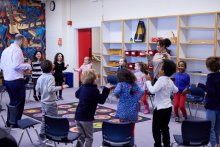
THE RHYTHM OF LOWER ELEMENTARY SCHOOL
Every Tuesday morning at 10:30 a.m., Kindergarten classes file into Molinari Hall in the Lower Elementary School where they are greeted by music teachers Billy Janiszewski (with a guitar over his shoulder) and Anitra Brooks. For 30 minutes, 90 children sing—in loud and soft voices, in English and other languages, trying to hit high notes and low notes. They also dance—tapping their bodies, waving their arms, and jumping.
On a recent morning, they were learning songs for Kindergarten Circus, a tradition performed by thousands of GCDS kindergarteners: “Flap, flap, flap, flap. Here come the seals with clap, clap, clap,” they sang, pretending to be seals.
The class is unbridled joy during which the students are fully engaged—body, mind, and heart. Nothing about the class, however, is random. Every moment of the class is planned and thought through.
“First and foremost in our minds is joy, joy, joy. We want them to walk out of class loving music,” says Ms. Brooks, who teaches Nursery, Pre-K students, and Kindergarten along with Mr. Janiszewski. “Part of how we achieve that is making sure that every single moment is planned and intentional."
“We never teach a song unless there’s a lesson in that song,” says Mr. Janiszewski, who also teaches Grades 1 and 2. “So it has to be either a rhythmic lesson, a pitch lesson, a lesson on dynamics, or a lesson on tempo.”
Mr. Janiszewski and Ms. Brooks, who started at GCDS in the last four years, are trained musicians who sing and play a variety of instruments, and they bring their expertise to work with LES students.
“All of the music work I’ve done really fuels my teaching, keeping the standard for excellence no matter what the age is,” says Mr. Janiszewski. “The only difference between how I approach a group of elementary age children versus how I approach a group of adults is the difficulty of the repertoire.”
“When I get into a classroom, I think to myself: ‘What can we create?’ What can we build with the sound that you just made? My focus is to get students to hear a rhythm, but more importantly, to feel the rhythm,” says Ms. Brooks.
“When they come to me in Kindergarten, they have a really strong sense of rhythm,” says Mr. Janiszewski.
In his classes, students put names to musical concepts. They learn the names of notes and concepts like piano (soft) and forte (loud), and begin the process of reading music. Students begin by playing small hand percussion instruments in Nursery and eventually play xylophones in Grade 2. In addition, students listen to a variety of music through their “Composers of the Week” program, learning about the music and lives of wellknown artists.
By the time students leave the Lower Elementary School, students have participated in several performances including the Halloween Parade, Winter Concerts, the Kindergarten Circus, Spring Concerts, and Grandparents’ Day.
The performances represent a shift that is occurring in the LES music program. “It’s an ‘informance’ as much as it is a performance, showcasing what we are learning in our classes,” says Ms. Brooks of the Nursery and Pre-K presentations.
The music teachers collaborate with the classroom teachers based on what the students are learning in class. For example, they look for harvest songs during the Pre-K farm unit and Lenape songs for Grade 2 when they study the indigenous tribe. Mr. Janiszewski works very closely with the Grade 1 and 2 teachers when they put on their classroom plays, often writing the music for them.
Mr. Janiszewski and Ms. Brooks spend a great deal of time and effort on music selection. They take into consideration the vocal range of children, which is much higher than an adult’s range. They also select from a broad range of composers to represent different cultures.
“I’m extremely particular about song choice. I want the children to sing high quality music and something worthwhile. It should also be a challenge, but an achievable one,” says Mr. Janiszewski.
For Ms. Brooks, music is a language unto itself, and she selects music in a variety of languages. She and Mr. Janiszewski both say that over their careers as singers they have sung in dozens of languages and they are excited about this growing part of the program.
“Intonation and the way that children use their voice and wrap their mouth around a word is something one can learn really early on. Parents have been amazed by what their children can sing,” says Ms. Brooks.
As Mr. Janiszewski and Ms. Brooks develop the LES music program, they look to their colleagues in the other divisions for both alignment and inspiration. The entire N–12 performing arts department meets regularly to discuss each other’s practices and chart the musical skills they are teaching from year to year, division to division. “It’s an incredibly talented team with a diverse, rich skill set. We are thinking about how what we teach in Nursery affects musical ability in Grade 12,” says Ms. Brooks.
Bios
Ms. Brooks: A singer-songwriter who is well-known in Greenwich for her music classes, she comes to music education from a theater and dance background. After receiving her degree in Theater Arts, she toured internationally with performance ensembles that created avant-garde musical and theatrical experiences. In the classroom, she draws on decades of being a performing artist.
Mr. Janiszewski: After graduating with a degree in music education as a voice major, Mr. Janiszewski received a master’s in choral conducting, and was the assistant director for the Oratorio Society of New York, a symphonic chorus founded in 1870.
#gcdsles #gcdsarts











.JPG&command_2=resize&height_2=85)





.jpg&command_2=resize&height_2=85)




